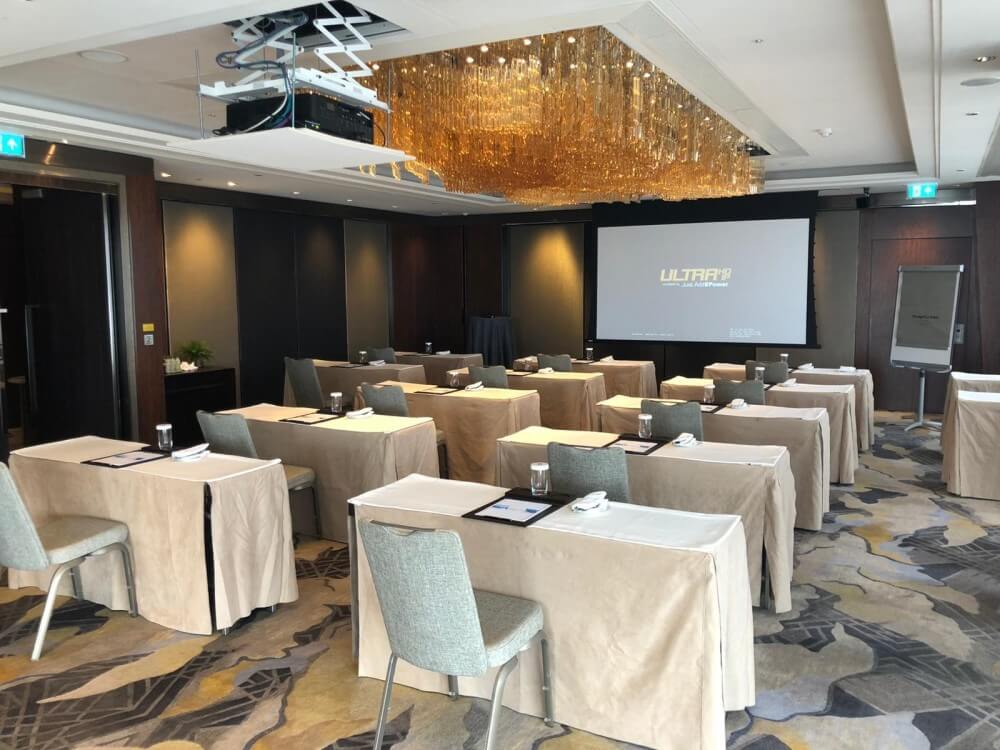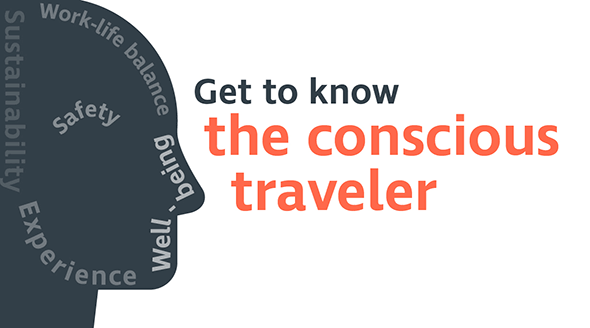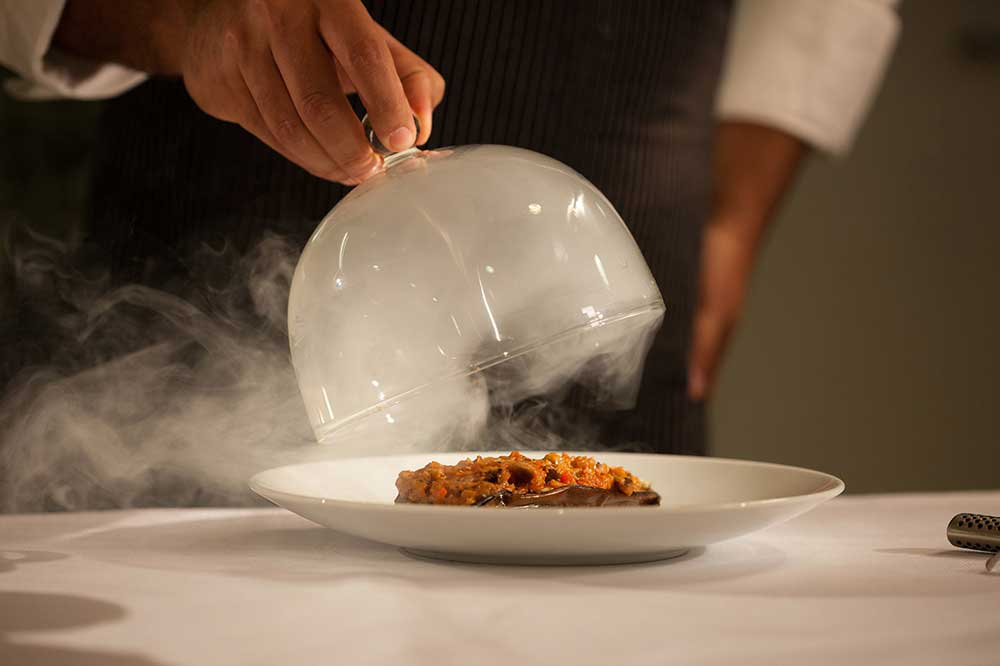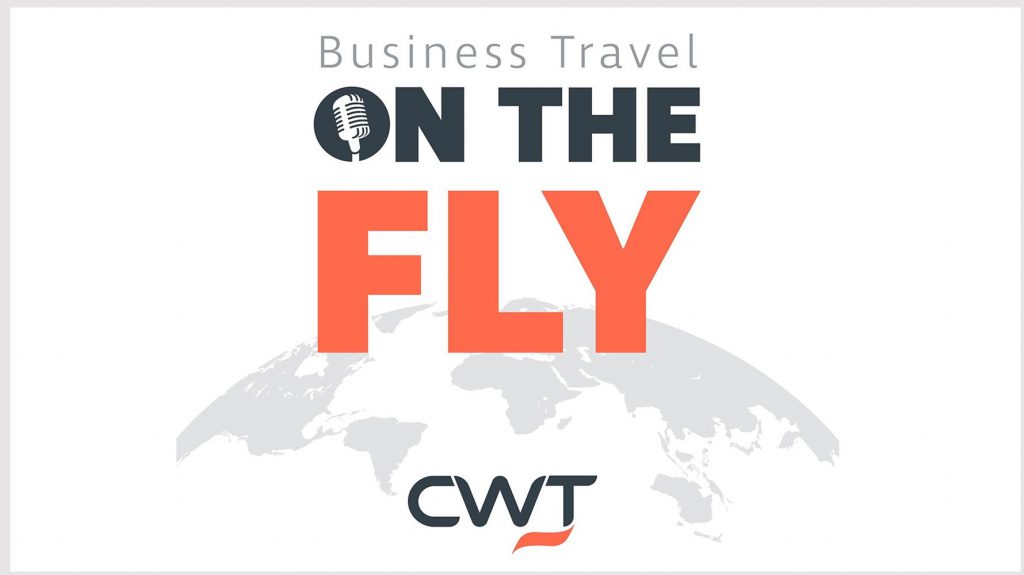Introducing the latest myCWT product and service enhancements
Building on our digital, omnichannel myCWT platform, our new products and services will simplify travel management for you and your employees – anytime, anywhere, anyhow.
Note: Featured services may not be available in your country at this time. Please reach out to your CWT representative for more details.
Hear from Chief Product Officer, Erica Antony as she shares the key product highlights of 2024, along with the key areas driving innovation.
-

2040: Baseline, Boom or Bust
As we enter an era of rapid transformation and unprecedented challenges, it is essential for travel managers, meeting & event planners, and corporate decision-makers to look ahead and frame our current strategic thinking with a clear vision of the future. Business travel and meetings and events (M&E) are poised for significant change over the next decade and a half, driven by a complex interplay of sustainability goals, technological advancements, evolving work models, and geopolitical dynamics.
In this paper to mark the 10th anniversary of our Global Business Travel Forecast, we explore, for the first time, a long-term vision of the future and potential trajectories through three distinct scenarios, each offering insights into how these forces should affect policy-making, budgeting and priorities. By examining these scenarios, we can better understand the diverse possibilities that lie ahead and the strategic imperatives required to thrive in each potential future.
Based on trajectory data analysis and interviews with industry leaders, behaviorists and climate tech founders, this forward-looking approach enables us to anticipate changes, strengthen our strategies, and make informed decisions that align long-term objectives. It is through this lens of foresight and adaptability that we can build resilience, seize opportunities, and navigate the complexities of the future.
We invite you to reflect on the insights presented, and consider how your organization can prepare for the opportunities and challenges that lie ahead. Together we can ensure that travel and meetings remain catalysts for growth, scalability and sustainable practices.
- Scenario development is both an art and a science
- Megatrends Shaping the Future of Business Travel, Meetings and Events
- Sustainability goals the new crux of corporate policy
- Technology Revolutionizes Travel Management
- Modern work models spark new travel patterns
- Changing demographics open doors to new opportunities
- Three Scenarios: Base case, boom and bust
- Future-proofing strategies

-

CWT GBTA Global business travel forecast 2025
When it comes to pricing, global business travel has finally reached an enduring, higher baseline. Prices will continue to rise in 2025, but only moderately, so expect a period of normalized growth.
However, this pricing environment, one of marginal gains and price regularity, is fragile. Global leisure travel has now realized a lot of its pent-up demand, while corporate travel has been resurgent, with 2024 edging at preCovid levels.
There are many factors at play, whether its volatile oil prices, labor costs and constraints, inflationary pressures, and geopolitical factors. As this elevated baseline edges upwards, albeit marginally, travel budgets will come under increased scrutiny, especially as travel patterns and attitudes change.
It’s why business travel can’t be viewed in a silo, and the true value to an organization must be fully realized. This forecast can help with those calculations.

-

Capitalize on emerging technologies in corporate travel
Technological advancements are accelerating at an unprecedented pace. How will emerging innovations like Generative AI, blockchain, and self-sovereign identity (SSI) transform corporate travel?
BTN and CWT probed global CEOs, travel managers, industry consultants and tech experts on the promises, questions, and expectations these innovations raise and how they are set to reshape traveler experience, cost control and service delivery in corporate travel and events.
Download and discover
- The technologies that will have the greatest impact on corporate travel in the next 2-5 years
- How these emerging technologies are poised to control costs, enhance service and security, and boost efficiency
- The critical challenges, opportunities, risks and roadblocks each innovation raises
- What travel managers, buyers and experts anticipate from these innovations

-

Staycations and Hybrid Meetings
In what now feels like a distant time, when business travelers were jet-setting around the world to attend meetings and events, some would tack on a couple of extra days to explore and enjoy the destination – a phenomenon that (for better or worse) has been dubbed “bleisure travel.” I’ve taken a few bleisure trips in my career, and last month while reminiscing about some of the more memorable ones, I felt like packing my bags and getting away. Unfortunately, the travel restrictions in place due to the pandemic meant I had to opt for the next best option – a “staycation” (which, for the uninitiated, means taking a vacation in the city where you live).
With much excitement, I booked a one-night stay at the luxurious Shangri-La hotel housed in The Shard, one of London’s most iconic buildings. The idea was to give my family something extraordinary to remember for years to come. At the same time, I would have the chance to survey the hotel’s meeting and event facilities. I guess you could say it was a bleisure trip in reverse – primarily a holiday, but with a little work sprinkled in.
Without hesitation, I can say the stay was terrific. From the welcome at reception, to the magnificent rooms, and everyone knowing the kids’ names, the attention to detail was impeccable. We dined at the Ting Restaurant, in a socially-distance and hyper-hygienic setting, as we enjoyed breath-taking views over the Tower of London, Tower Bridge and rest of this beautiful city. But if you were to ask my kids, they would undoubtedly tell you that the highlight of the entire experience was swimming in the pool on the 52nd floor!
While the wife and kids were busy having their second swim of the day, I took the opportunity to catch up with Joe Broughton, Senior Event Sales Manager at Shangri-La Hotels and Resorts, who gave me a tour of the property and showed me how they are adapting and evolving to host meetings in a post-covid world.
It was a fantastic experience that gave me a first-hand look at how the hotel industry is preparing for travel and meetings & events post-covid.

A socially distanced hybrid event set-up (Photo: Ian Cummings) Cleanliness has long been a key part of hotels’ value proposition, but now many hoteliers have launched new initiatives to step up their hygiene standards as health and safety has far and away become the top priority. Measures such as regularly disinfecting common areas like meeting rooms and elevators, placing hand sanitizers across the property, and requiring guests to maintain social distancing and/or wear masks now appear to be par for the course.
Some hotels are also enhancing their technical capabilities, in anticipation of a greater number of hybrid events moving forward. The Shangri-La at The Shard, for example, can have a TV studio-type set up so that organizers can broadcast an event taking place at the property to the attendees joining virtually. As the events industry emerges from the pandemic, its likely more local and hybrid events will be the first to resume, and we have seen many hotels adapting to provide TV studio type setups.
And finally, we can expect to see hotels being a lot more adaptable in how they allocate space – for example, giving organizers exclusive use of certain sections of the property in order to limit contact with attendees from other groups. During our tour, Joe showed me how they are turning rooms into private lunch or dining experiences for six or eight people, or for a board meeting.
While there can obviously be no compromises made when it comes to health and safety, there are ways to work these considerations into event flows and ensure that we can still be creative and fun with the way we meet. My colleague Michelle Sargent, who leads our M&E team in Australia, was telling me about a hotel that assembled a “gin trolley” of hand sanitizers produced by various local distilleries, and their “Sanitizer Sommelier” wheeled it around the conference room allowing attendees to pick their choice of sanitizer.
Personally, I’m really looking forward to a time when we can meet face-to-face again. We now see some governments ease meeting restrictions, especially in the UK where indoor events of up to 1000 people are allowed. My experience at the Shangri-La makes me feel confident that as in-person meetings resume, we will be able to do so in a manner that is both safe and engaging. In the meantime, we’ll be here to help you create exciting and memorable events that deliver a strong ROI even in today’s “virtual” reality.
The Skypool photo: Shangri-La Hotels & Resorts
-

CWT appoints Laura Watterson as Chief Human Resources Officer
CWT, the Business-to-Business-for-Employees (B2B4E) travel management platform, announces the appointment of Laura Watterson as Chief Human Resources Officer, with effect from 5 July 2022. Laura will report to Patrick Andersen, CWT’s President & Chief Executive Officer, and be a member of the company’s Executive Leadership Team. Laura takes over from Catherine Maguire-Vielle, who is stepping down and leaving the company to pursue new professional opportunities.
“I am delighted and excited to welcome Laura back to CWT, and I know that her skills, flair, and talents will be a core ingredient of our success as we enter the next phase of our company’s growth story,” said Patrick Andersen. “At the same time, I am sorry to say farewell to Catherine, who has been a rock for us, as we faced the adversity and headwinds of recent years – and I know I speak for us all in wishing her every success for the future.”
Laura re-joins CWT from Cambria, where she served as Chief Human Resources & Risk Officer, having been CWT’s SVP – Global Talent & Rewards before that. A former chief human resources officer at Johnson Brothers Liquor Company, Laura began her career at General Mills Inc in 2000, and has since held several leadership positions, including Global Director of HR at Philips Electronics, and VP Talent and Culture at Aimia. Laura has a proven track record of delivering positive impact in multiple industries and Fortune 500 companies through superior human resource management, implementing innovative talent movement processes to improve depth and deployment, and creating sustainable people infrastructure.
She holds a Master’s in Industrial and Labor Relations from Cornell University and a Bachelor of Arts in French from Washington and Lee University.
CWT is a leading global partner in business travel, meetings, and events. Operating across six continents, we deliver sustainable, tailored solutions that help organizations connect, engage, and thrive in an evolving world. Our myCWT platform integrates advanced technology with human expertise to simplify travel and enhance traveler and attendee experiences. Extensive global coverage, seamless data integration, AI-driven analytics, and carbon-conscious travel tools enable businesses to optimize their travel and meetings programs while delivering measurable value.
With 150 years of industry experience and a deep commitment to partnership, CWT collaborates with clients to shape the future of business travel and events, making them more efficient, responsible, and impactful.
-

The age of the conscious business traveler
Volatility, complexity and change brought on by the pandemic has been a huge social and economic disrupter for most. It has – and continues to – transform the way in which we interact, consume, work and travel.
What influence does this change have on business travelers’ behaviours, needs and expectations?
In this episode Christina Scorsis, CWT’s VP Traveler Experience Evolution, opines about her own shifting attitudes, and how companies and organizations can keep pace with the aspirations and expectations of the conscious business traveler to retain talent and support a healthy company culture.
Find out:
- About changing patterns of business travel.
- How travel managers should engage their conscious travelers.
- Empowering business travelers to make the most sustainable decisions when booking a trip.
[buzzsprout episode=’10834882′ player=’true’]
-

Nice little earner: Can a business trip help you save money?
The rising cost of food, energy and fuel are cause for concern for millions. A recent report by credit score company Experian found that 71% of Americans feel their pay check is not able to keep up with inflation. Higher earners are no exception. Half of workers earning more than $100,000 said they have little to nothing left over at the end of the month, according to a poll of 3,250 people by financial platform Lending Club.
In the UK the Official for National Statistics reports that 75% of adults worry about the rising cost of living, with half of them doing so on a daily basis.
Inflation is outpacing wage growth right now. So, if your upcoming sales meeting is occupying less headspace than your gas bill, you may find solace in making business travel work for your wallet.
Take advantage of someone else footing the bill
Providing it fits within your company’s policy and budget restrictions, use your business trip to take the opportunity to stay at the boutique hotel you’ve seen in magazines, eat at the fancy restaurant with the Michelin star, or upgrade your flight to the next class. Enjoy some of the finer things that your personal budget won’t stretch to.
Rent out your home
You’ll find dozens of apps that let you make money from your space. From renting out your driveway, your living room as a photoshoot or workshop venue to hiring your place out on Airbnb, it’s easier than ever to earn relatively passive income while you’re away. And if you don’t rent your place out, you’ll have a chance to save on utilities while your home isn’t in use. Just remember to turn off the lights.
Bleisure boost
Fewer things are harder to bear than lockdowns, expect perhaps, the word ‘bleisure.’ Unpalatable portmanteau notwithstanding, the benefits of combining business with leisure travel are especially acute now.
Pent-up demand is showing no signs of abating. A May TripAdvisor index found that 77% of Singaporeans, for example, said they were either “extremely” or “very” concerned about rising costs, yet nearly 40% more people plan to travel this summer than in the last. If you need a break, you might as well let work cover the travel to and from your destination, and tack on leisure time after your meetings.
Tick off a financial task
Working parents or carers know that free evenings midweek are like a solar eclipse blood moon. They occur about three times a year. Not so when you’re in a hotel room, flying solo. Use the hours not spent loading the dishwasher to tick off financial admin such as tweaking your home budget, researching cheaper utilities providers or looking into investment opportunities.
Saving money, renting out your home, tacking on a mini break and using free time to plan your financial future are all ways to benefit in small ways from a return to business travel.
-

7 lessons to improve your non-verbal communication
While Zoom, Webex and virtual events have dominated meetings in the last couple of years and were a welcome and necessary adaptation to our business lives, they made it more difficult to pick up non-verbal cues that we get from being physically present in a room with people. The transition was made even harder as people were easily distracted by other digital interests or just didn’t turn their camera on.
That left us with almost no way of reading non-verbal cues during meetings – a vital element for effective communication. Many studies have shown that non-verbal behaviors make up a large percentage of our daily interpersonal communication. Most experts agree that 70 to 93 percent of all communication is non-verbal, indicating the importance of the ability to ‘read’ people wholly through their body language, while also listening to their words.
Now that in-person meetings and events are back for most of us, and there is pent-up demand for business travel we identify some of the non-verbal ways we all communicate that are useful to be aware of for your next meeting.
1. Make proper eye contact
Eye contact makes up a huge part of non-verbal communication. Keeping eye contact while communicating is a good way to show others that you’re engaged and attentive while they’re speaking. To practice good eye contact, keep your eyes on the individual’s face while they speak and continue to look at them when you reply, but avoid staring. If you are speaking to a group, try to make eye contact briefly with everyone in the room, even those at the back, rather than focus on just one or two individuals.
However, be aware that in some cultures, lack of eye contact signals disinterest. In others, too much direct eye contact might make people uncomfortable.
2. Be aware of body language
Your posture matters a great deal. Stand or sit up straight and face your audience openly and with attention. If appropriate, move around a bit and use hand gestures to emphasize your points. Avoid crossing your arms and legs, picking your nails or fidgeting. This can all imply you are uncomfortable, not interested or even defensive. Also, respect people’s personal space and remember that different cultures and individuals can have different norms and preferences about proximity and touch.
3. Facial expressions don’t lie
Facial expressions are closely tied to our emotions and easily reveal what we are thinking and feeling. We naturally make all sorts of facial expressions when we interact with others. Consider how much information can be conveyed with a nod, smile or frown. Be aware of your own facial expressions and practice relaxing your facial muscles in front of a mirror to convey an open gaze, and even a smile while you are at it. You will notice it will be easier and more engaging to grab someone’s attention and interest in what you are saying.
4. Play with your tone of voice
Your vocal tone is another important form of non-verbal communication. It can convey emotion and feelings, such as happiness, sadness, anger and boredom. When you speak, pay attention to your tone and be conscious how it affects other people as it can be an effective way to amplify your message. If you are excited and passionate about what you’re speaking about and reflect that in your tone of voice, it will encourage others to share your enthusiasm and stay engaged. We’ve all witnessed speakers whose tone is on a single level. Did you find your mind wandering? Did you lose interest in what they were saying? Try not to be that person. Avoid speaking too fast or too slow and make sure you articulate well.
5. Pay attention to discrepancies in behavior
If someone’s words don’t match their non-verbal expressions or actions or if a team member says they’re excited to work on a new project but is staring at the ground or frowning, they might not be as happy as they say. Pick up these signals and dig deeper to find out the problem and how you can support.
6. When in doubt, ask
One of the biggest risks of decoding non-verbal communication is wrongly interpreting the signs. When you are confused or in doubt of someone’s non-verbal cues, ask for clarification. This way you prevent a misunderstanding. And by inquiring further into people’s message and intent, you might gain a better understanding of what they’re really trying to say.
7. Practice makes perfect
Some people might have a natural talent for picking up non-verbal cues. If you are not one of them, don’t worry. You can improve your skills by practicing. Watching how other people communicate non-verbally is a good way to learn what works and what doesn’t. Also consider interacting with friends and family and asking them for feedback on your non-verbal communication. Practicing these skills allows you to become more familiar with how you personally express yourself.
-

CWT strengthens its global sales organization capabilities
CWT, the Business-to-Business-for-Employees (B2B4E) travel management platform is expanding its global footprint with the recruitment of multiple highly experienced specialist sales leaders, who will play a fundamental role in the successful delivery of CWT’s customer growth priorities. Doug Vincent joins as Vice President, Enterprise Sales Defense & Government; Patrick Burke is appointed as Director, Sales NORAM; Thomas Nicholson is confirmed as Director of Sales NORAM and Sergiu Les as Director of Sales EMEA; Alberto Porragas is appointed as Sales Manager Mexico and both Uschi Koch and Joanna Brewer join as Sales Managers, EMEA.
“We’re excited to have such talented and experienced sales professionals strengthen our expanding global sales team, at a time when travel rebound is rapidly gathering pace,” said Darren Toohey, Head of Global Sales. “Collectively and individually, the energy and drive Doug, Patrick Tom, Sergiu, Alberto, Uschi and Joanna bring to our organization, is already beginning to reap positive customer growth and scale rewards.”
Based in Florida, Doug Vincent will serve on CWT’s Enterprise Sales Team and be responsible for new business focused on the defense and government contractor industry. A recently retired veteran of the US Army and a Colonel of Infantry, Doug brings 30 years of Defense and Government knowledge to the role, having been deployed to combat five times and earned numerous military awards and medals throughout his distinguished military career. With deep industry knowledge, his primary focus will hinge around leveraging CWT’s solutions and technology to advance travel programs of defence contractors.
With over a decade of global TMC experience and most recently in the travel technology sector with TripActions, Sergiu Les brings deep knowledge of end-to-end customer growth management to CWT’s EMEA customer operations. Drawn to CWT by its compelling global tech stack and future roadmap for deployment, France based Sergiu’s primary remit will be centered around strengthening CWT’s Enterprise sales segment.
Uschi Koch rejoins CWT after spending the last six years honing her business development and key account management skills outside of the business travel sector, whilst embarking on studies to become a Certified Quality Assurance Manager. Based in Switzerland, Uschi will be responsible for providing value, flexibility and customized experiences to CWT EMEA prospects and clients.
Joanna Brewer joins CWT via Enterprise Rent-a-Car. Her 20 years there, saw her most recently build and lead their TMC strategy for EMEA. Having recently completed an executive MBA, Joanna’s drive to achieve, positions her well to progress CWT’s European customer growth ambitions alongside Sergiu, Uschi, and CWT’s EMEA customer sales team.
California based Patrick Burke joins CWT via the airline world, where he spent two decades with Air France KLM. His 20 years at the airline saw him progress from regional commercial management roles to leading global multinational account sales. In his new position, Patrick will focus on CWT’s multinational sales efforts in the United States and will use his expertise in oil and gas markets to further develop the energy, resources and marine vertical business.
Based in Mexico City, Alberto has more than 20 years of experience developing new corporate business at Delta, KLM, Air France and Copa Airlines from the TMCs side, leading and executing Sales, Marketing and even Customer Service strategies. Now he is bringing that successful track record from the airline industry to CWT, where he will be responsible for CWT’s local and regional sales efforts to achieve nonstop new customer growth in the Latin-American marketplace.
Seattle based corporate travel industry veteran, Thomas Nicholson has worked for Tripbam, American Express GBT, United Airlines UATP, Worldspan and Hertz over the last 25 years. In joining CWT, Tom will be responsible for CWT’s northwestern US multinational sales efforts, working alongside Patrick and the rest of the North American sales team to achieve continuous new customer growth in the market.
CWT is a leading global partner in business travel, meetings, and events. Operating across six continents, we deliver sustainable, tailored solutions that help organizations connect, engage, and thrive in an evolving world. Our myCWT platform integrates advanced technology with human expertise to simplify travel and enhance traveler and attendee experiences. Extensive global coverage, seamless data integration, AI-driven analytics, and carbon-conscious travel tools enable businesses to optimize their travel and meetings programs while delivering measurable value.
With 150 years of industry experience and a deep commitment to partnership, CWT collaborates with clients to shape the future of business travel and events, making them more efficient, responsible, and impactful.
-

Get to know the conscious traveler
With a new attitude of awareness for themselves, others and their environment, the expectations and role of business travelers are evolving. They want more. They do not want only to follow the policies, but help shape the program with more options and choices. By understanding the changed behavior and needs of your travelers, you can create a travel program that is optimized for your travelers and your business. So now it is time to rethink, revise and re-evaluate your travel program.


Get to know the conscious traveler
Travelers are now more mindful and conscious of their well-being, work-life balance, and impact on the environment. How does this translate to the needs of today’s business travelers?

5 tips to engage your conscious traveler
CWT experts provide tips and recommendations on how to shape your travel program to meet the needs of the conscious traveler.
-

CWT appoints Mike Douglass to newly created role of TX Customer and Service Excellence Leader
CWT, the Business-to-Business-for-Employees (B2B4E) travel management platform, announces the appointment of Mike Douglass as TX Customer and Service Excellence Leader, effective immediately. Responsible for leading the development of the traveler experience (TX) throughout the customer lifecycle, Mike will report to Derek Sharp, Chief Traveler Experience Officer, and be a member of the company’s Traveler Experience Leadership Team.
“I am excited about the potential of this newly created, key role, and I am delighted that we have found someone of Mike’s unique skills and talent to shape it for us,” said Derek Sharp, CWT’s Chief Traveler Experience Officer. “Service excellence has always been a core element of CWT’s proposition, and, as corporate travel returns with a vengeance, Mike and his team will be at the vanguard of our focus here.”
Prior to his appointment, Mike was most recently Senior Vice President – Airlines at Amadeus IT Group, and he brings nearly 30 years’ travel industry experience to CWT, from multiple executive and leadership positions across many business disciplines. His previous roles include Vice President of Americas – Air Travel Commerce at Travelport, Regional Vice President/General Manager – Americas at Sabre Airline Solutions, Business Development Manager – Airline Management Services at American Airlines, and Senior Vice President of Sales & Marketing at Global Eagle Entertainment (now renamed Anuvu Operations LLC).
CWT is a leading global partner in business travel, meetings, and events. Operating across six continents, we deliver sustainable, tailored solutions that help organizations connect, engage, and thrive in an evolving world. Our myCWT platform integrates advanced technology with human expertise to simplify travel and enhance traveler and attendee experiences. Extensive global coverage, seamless data integration, AI-driven analytics, and carbon-conscious travel tools enable businesses to optimize their travel and meetings programs while delivering measurable value.
With 150 years of industry experience and a deep commitment to partnership, CWT collaborates with clients to shape the future of business travel and events, making them more efficient, responsible, and impactful.
-

CWT launches 24/7 English-Mandarin bilingual service hub
Located in Singapore, the service center is designed to provide convenient business travel support to the overseas employees of large Chinese companies.
CWT, the business-to-business-for-employees (B2B4E) travel management platform, has launched a new bilingual service center that will offer companies round-the-clock travel assistance in English and Mandarin. This is in response to a growing demand from Chinese multinationals that require a convenient and consistent corporate travel experience for their employees based outside of China.
The service center, located in Singapore, consists of a team of travel counselors who are fluent in both languages and have received special training in Chinese culture and traveler preferences. Companies that sign up for this service will have access to 24/7 assistance for their employees’ travel arrangements including flight, ground transport and hotel bookings, as well as on-trip support in the event of trip disruptions such as flight delays and cancelations.
“We have seen a swift resumption in travel by our Chinese clients’ overseas employees, as countries around the world have relaxed restrictions,” said Albert Zhong, General Manager, China, CWT. “In the case of certain companies, these travelers are already traveling as much—or even more—than they were pre-pandemic. Through our new bilingual service hub in Singapore, we can provide our Chinese customers and their employees around the world with a more consistent experience, whenever they need support, and in their preferred language.”
One of China’s biggest technology companies became the first customer to begin using this service in May, and the feedback from their travelers has been overwhelmingly positive. CWT also has several other large Chinese multinational clients that have expressed interest and are expected to go live later this year.
CWT first entered China in 1996, with China Air Service (CAS) as its appointed partner. In 2003, CWT and CAS established a joint venture, CWT China, which now has offices in Beijing, Guangzhou, Meishan, Shanghai and Tianjin. The business has grown from supporting the Chinese operations of CWT’s international clients to increasingly working with more homegrown Chinese companies as the country’s corporate travel market has matured. In 2021, three in every five new customers signed by CWT China were local companies.
CWT also established its Asia Pacific regional headquarters in Singapore in 1996. Singapore was deemed to be the ideal location for this new bilingual service center, given the easy access to a wide pool of travel counselors who speak both English and Mandarin, as well as the existing technology and extensive experience that CWT’s teams in Singapore have in operating similar service hubs.
CWT is a leading global partner in business travel, meetings, and events. Operating across six continents, we deliver sustainable, tailored solutions that help organizations connect, engage, and thrive in an evolving world. Our myCWT platform integrates advanced technology with human expertise to simplify travel and enhance traveler and attendee experiences. Extensive global coverage, seamless data integration, AI-driven analytics, and carbon-conscious travel tools enable businesses to optimize their travel and meetings programs while delivering measurable value.
With 150 years of industry experience and a deep commitment to partnership, CWT collaborates with clients to shape the future of business travel and events, making them more efficient, responsible, and impactful.
-

How to build a more sustainable hospitality industry
“It’s not easy being green,” said Kermit the frog. It’s a lament we can empathise with despite ‘being green’ topping the priority list of business travelers across the globe. 87% of CWT’s customers surveyed last year said they wanted sustainability information provided to their traveling employees at the point-of sale. Now that business travel is well and truly taking off again, industry publication The Beat reports that domestic and short-haul business trips in North America and Europe are already back to 2019 levels – so too is pressure on the planet.
Hot on the heels of World Environment Day on Sunday 5 June 2022, many are wondering how we go forward in a more sustainable fashion.
That’s the subject of our latest podcast episode, ‘A green standard in hospitality’ featuring CWT’s Chief Growth Officer Belinda Hindmarsh and Kit Brennan, Co-founder and Director of award-winning carbon intelligence platform Thrust Carbon.
CWT became the first major global travel management platform to partner with Thrust Carbon to activate point-of-sale emissions data enabling travelers to make the most eco-friendly decision at the time of booking.
“Sustainability is very focused on airlines…but getting to ‘net zero’ means every part of the travel sector says Kit Brennan. “Looking at the hotel sector you start to see a myriad of things that all need to be worked out in tandem – from construction to food, amenities, single-use plastics and everything in a wider ESG (environmental, social and governance) sense. It’s mind-bogglingly large.”
There are great strides being made and much more to be done.
Three priorities can help the sector evolve
Transparency
“It’s one thing if a hotel is measuring its carbon emissions but trying to find out can be difficult if there’s no public sharing,” says Brennan. “We have a lot of magic that happens behind the scenes to put together our hotel sustainability index but without accurate data on a per-property level, it can be difficult. We need to see something happen on an industry body level in a standardised way, and governments will need to step in to demand that hotels publicly share data.”
Inclusivity
“There are measures in place today but it’s voluntary and doesn’t necessarily include everything,” says CWT’s Belinda Hindmarsh. “Indeed, if the wider industry can get even more carbon data then you can really start educating customers at point-of-sale and evolve the discussion. It’s about expanding the methodology and having a system that everyone needs to report into,” adds Kit.
Built-in, not bolted on
“I don’t think I’ve seen an RFP come through the door in two years where there hasn’t been questions about sustainability,” says Belinda. “Organisations are trying to figure out the sweet spot between cost, wellbeing and greener travel. I was shocked to learn that around 90% of our consulting engagements since Q4 last year were focused on responsible travel, getting the right hotels in the program and the wellbeing and green travel balance. Sustainability needs to be built into the travel program, not seen as a bolt-on.”
For more on evolving sustainability in the hotel sector and what you can do as a traveler listen to ‘A green standard in hospitality.’
-

Private dining – trends across Europe
The trends across the European private dining scene have taken a turn. There is a shift in culinary awareness, with so many new chefs landing on the food scene, bringing vast knowledge and finesse from different parts of the world. Venues are starting to go above and beyond when hosting guests, to make it a night that their attendees won’t forget.
What can we expect for private dining in 2022?
Less but more
Portion sizes are decreasing, but the number of dishes served over one meal is on the up. After all, they say big things come in small packages. It is becoming a popular choice in the private dining scene, as attendees get to try lots of new and exciting flavours, from a range of cuisines. It is also the perfect conversation starter, amongst colleagues. Nothing brings people closer together than food.
Quality drink pairings
As dish quantity is on the rise, and flavors and aromas being the essential part of every dining experience – the popularity of little bites has been given rise to more cocktail and wine pairings. Think beef carpaccio served with Grenache Blanc from St Roch Vieilles Vignes or a beef fillet with a Gorgonzola crust, served with a Malbec from Chateau Labastide Haute, which is what you can find in London, at the Hampshire Hotel, one of the Edwardian Hotel’s private dining experiences.
Local and seasonal
More chefs are trying to change their dining menu selection to fit the season. Not only does the nutritional value increase, but the product is also at its prime as a result of the weather conditions. Using “in-season” ingredients also means it has not traveled from far and wide to reach your plate, ensuring freshness, ripeness, better texture and flavours.

Vegan fine dining
Veganism is on the up, which also brings a whole new element to private dining. Vegan food has moved on from “comfort food” such as tofu burgers and chutneys to the likes of beetroot caviar and grilled shitake tartare. What’s not to love?
Zero waste eating
Food waste is something many chefs are battling against, especially with many local farmers are going to the extent of producing the best ingredients possible that bring out the best culinary experience to diners palettes’, why waste it? Plus, a lot of the components we tend to throw away come with rather distinctive smoky, floral and earthy flavours, taking dishes to a whole new level.
-

On the road again: My first business trip, post-lockdown
With business travel recovery in full swing, CWT’s Robin Handley lays out what to expect on most international trips. Turns out it’s not so daunting after all.
I used to travel for work quite a bit before the pandemic. So, when I was recently asked to join my peers in London after the long pause of Covid, I admit I was really looking forward to it.
I quickly realized there were noticeable differences in my end-to-end trip experience. Not bad, just different. Traveling these days takes extra preparation, thoughtful planning, and, perhaps above all, patience with the new normal.
As with any trip, I started by making sure my profile information was complete and accurate. When I paused to think of just how long it had been since I travelled internationally, I experienced a brief wave of panic. Passport!?! Fortunately, my passport, Global Entry and TSA pre-check had not expired. I was good.
About a week prior to my departure date, I started to look into Covid restrictions. I think this pre-travel research is intimidating for many travelers post-Covid. Who can keep up? Fortunately, using the myCWT platform made access to this information quick and easy and knowing any relevant security alerts or advisories would be sent to me, I had the information I needed to travel with confidence.
I was ready to pack my bags. Unsure of what to expect when I got to the airport I was grateful that I had already mastered the art of packing a week’s worth of clothes, shoes, and toiletries in a single carry-on. That is one thing that I didn’t expect would change — traveling with less is better.
One last piece of the planning puzzle: Transportation to the airport. I live a good distance from the airport. Considering the rising cost of gas, tolls and parking, it ended up being more cost-effective using a car service. Times have changed.
Upon arrival at Chicago O’Hare international airport, I was pleased to see the terminals bustling with travelers. The mask mandate had been lifted and there was a mix of people with or without masks and that felt pretty normal. It is what I had expected and I think what we can all expect moving forward. It is a personal choice.
Getting through security had not changed much. With my digital boarding pass on my mobile phone, I zipped right through and worked my way to the lounge. Patrons were pretty spread out in the lounge and I noticed the “help yourself” buffet style snacks had been replaced with QR codes to view and order food and beverages. Different but just as convenient.
I know the carriers do a tremendous job of deep cleaning the aircraft, however part of getting situated in my seat included wiping down the surfaces with an anti-bacterial wipe. I noticed a few others do the same as an added safety precaution.
The experience for the duration of the plane ride in business class felt very similar to pre-pandemic days. I was offered water, champagne or juice before take-off and regular food service was offered with glassware, silverware and china. This was really nice and I was glad the airline recognized this experience as something business travelers value.
After arriving in London, I met one of colleagues near baggage claim and we shared an Uber ride to our hotel. Ridesharing was still the most convenient and cost saving choice of ground transportation.
We had 2 ½ days of in-person meetings as well as an opportunity to spend time with some of our suppliers. The personal connections, ability to cover a vast range of topics and strategic planning was truly incredible and something you just cannot replicate via a web conference. It was clear my peers were equally appreciative of the face time—proof that travel will always be a critical business lever.
Twenty-four hours before my return flight home, I was required to take an antigen Covid-19 test to show proof of a negative result. The process was surprisingly easy and fluid. My results were sent to me via email within an hour and I simply uploaded them on the airline app and electronically completed my attestation form and proof of vaccination. I was cleared to go home. Despite feeling safe the whole time, I had a big sigh of relief.
It felt so good to travel internationally again and see the airports filled with so many people, clearly excited to be travelling again too. The end-to-end experience gives new meaning to Willie Nelson’s classic… ”I can’t wait to get on the road again!” even if some things are different.
Image credits: Adobe Stock
